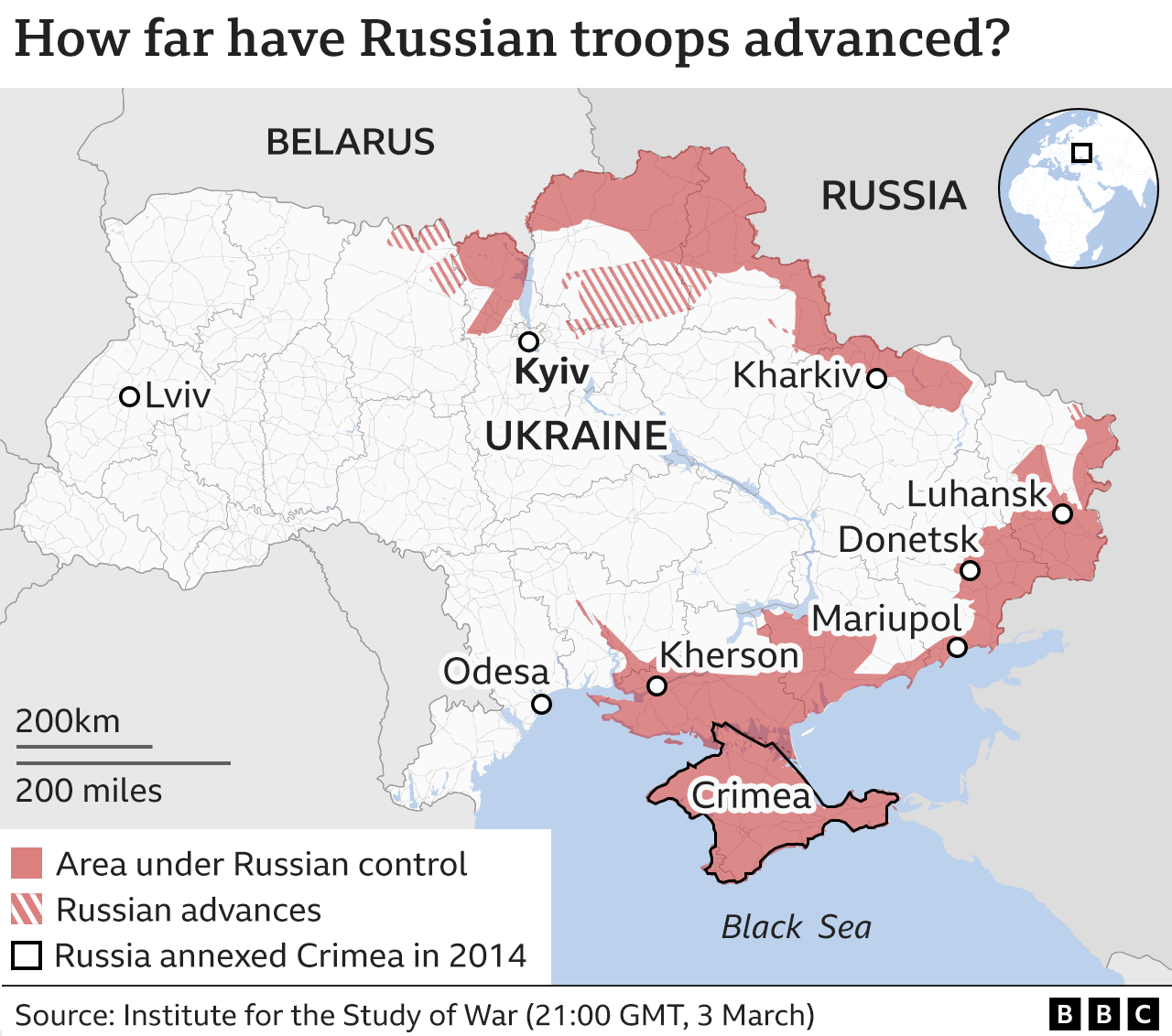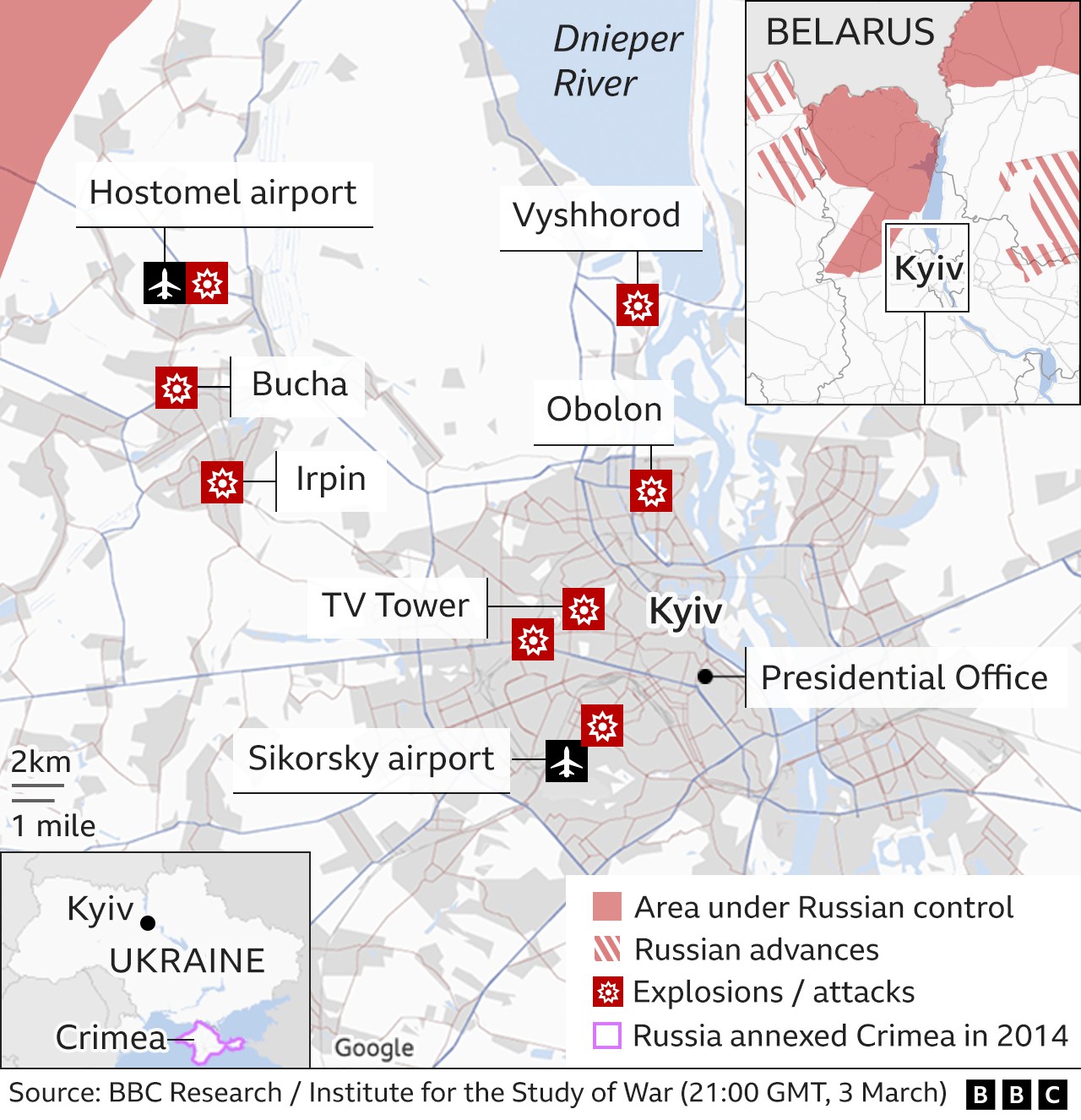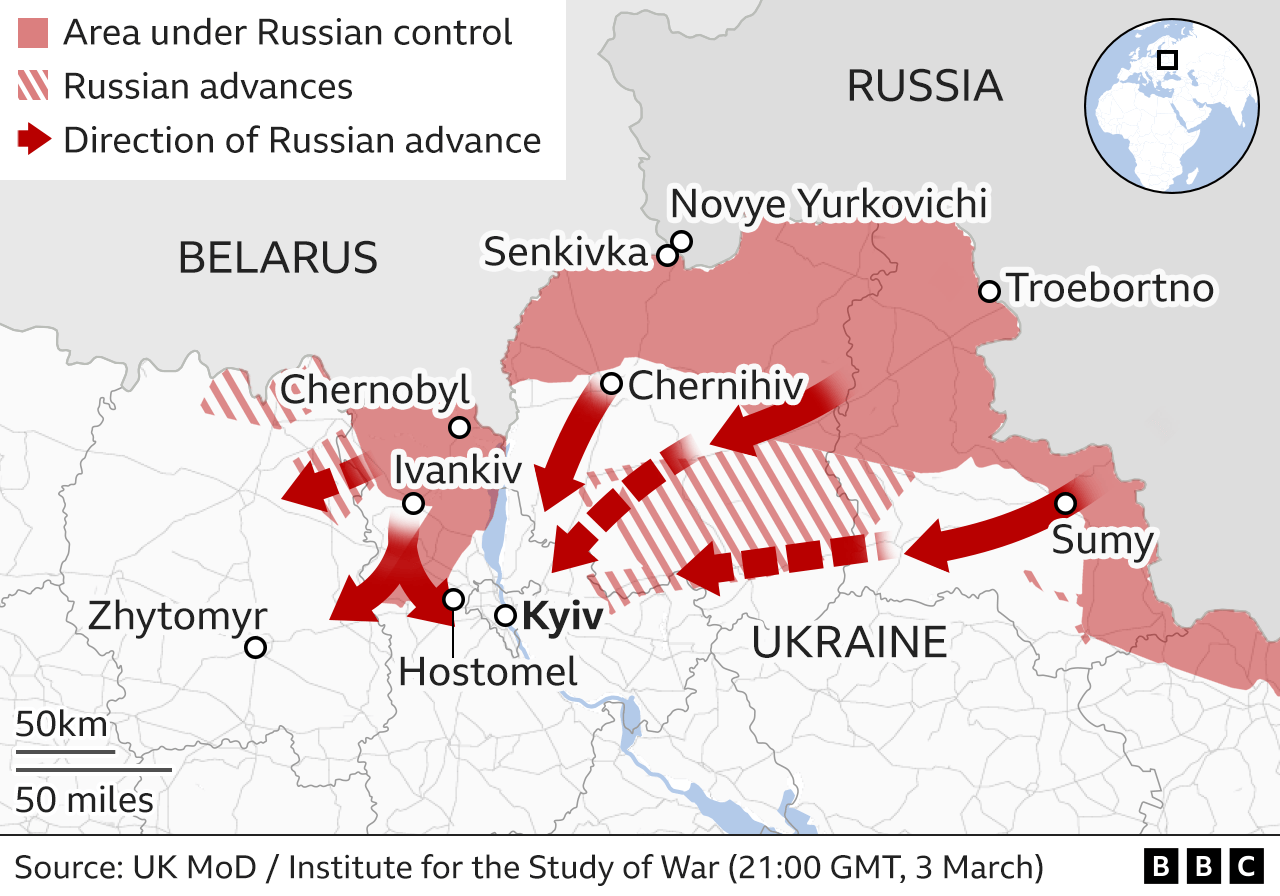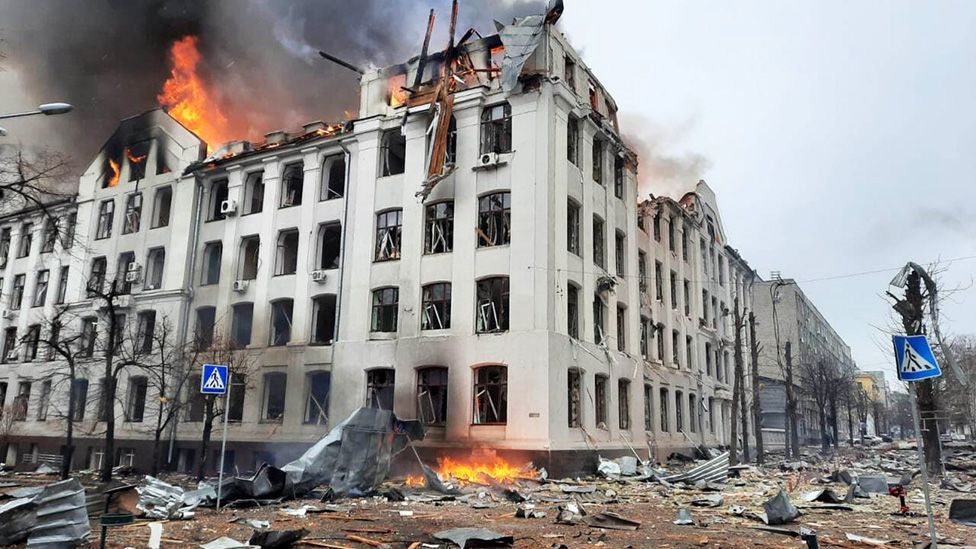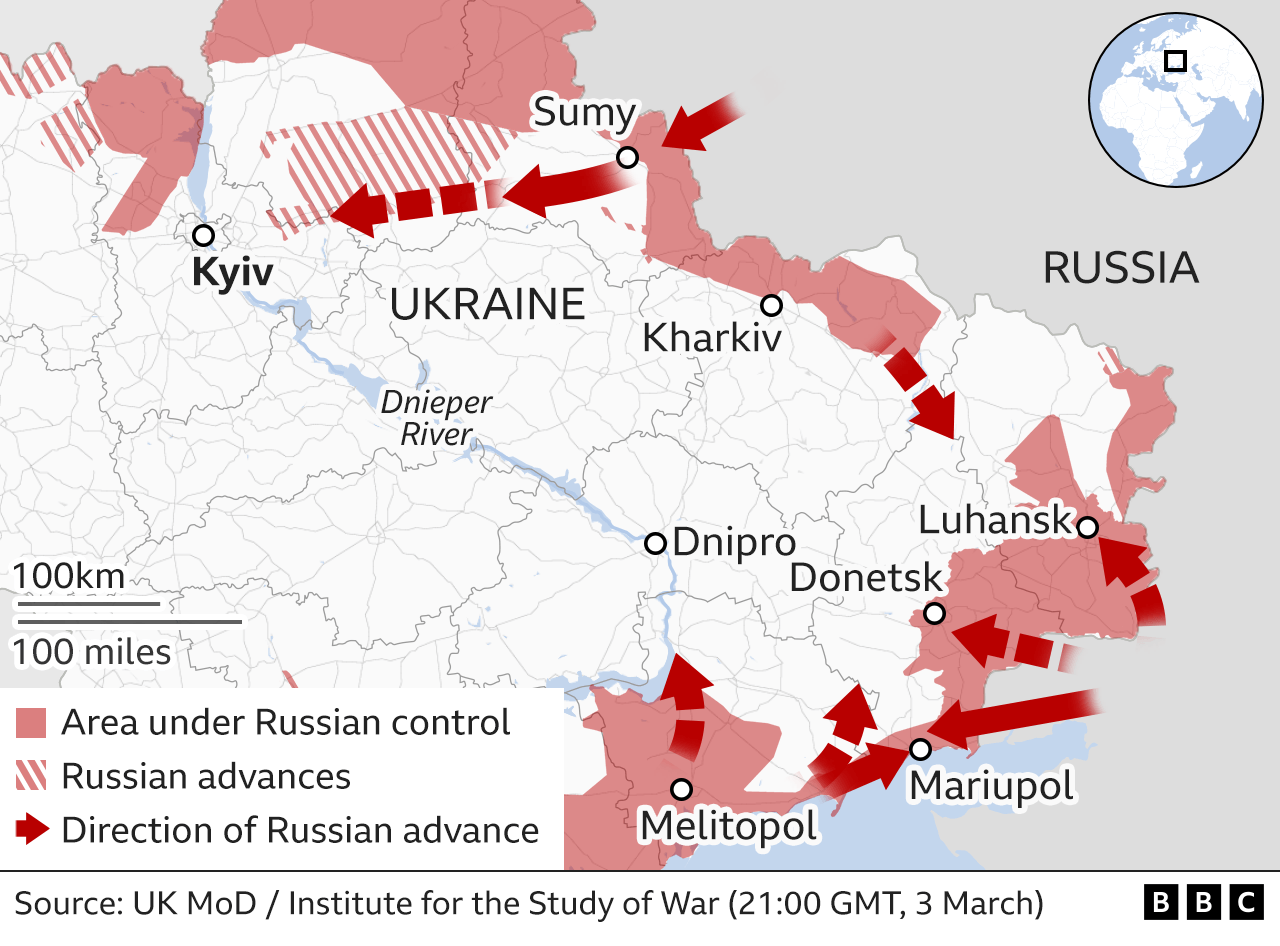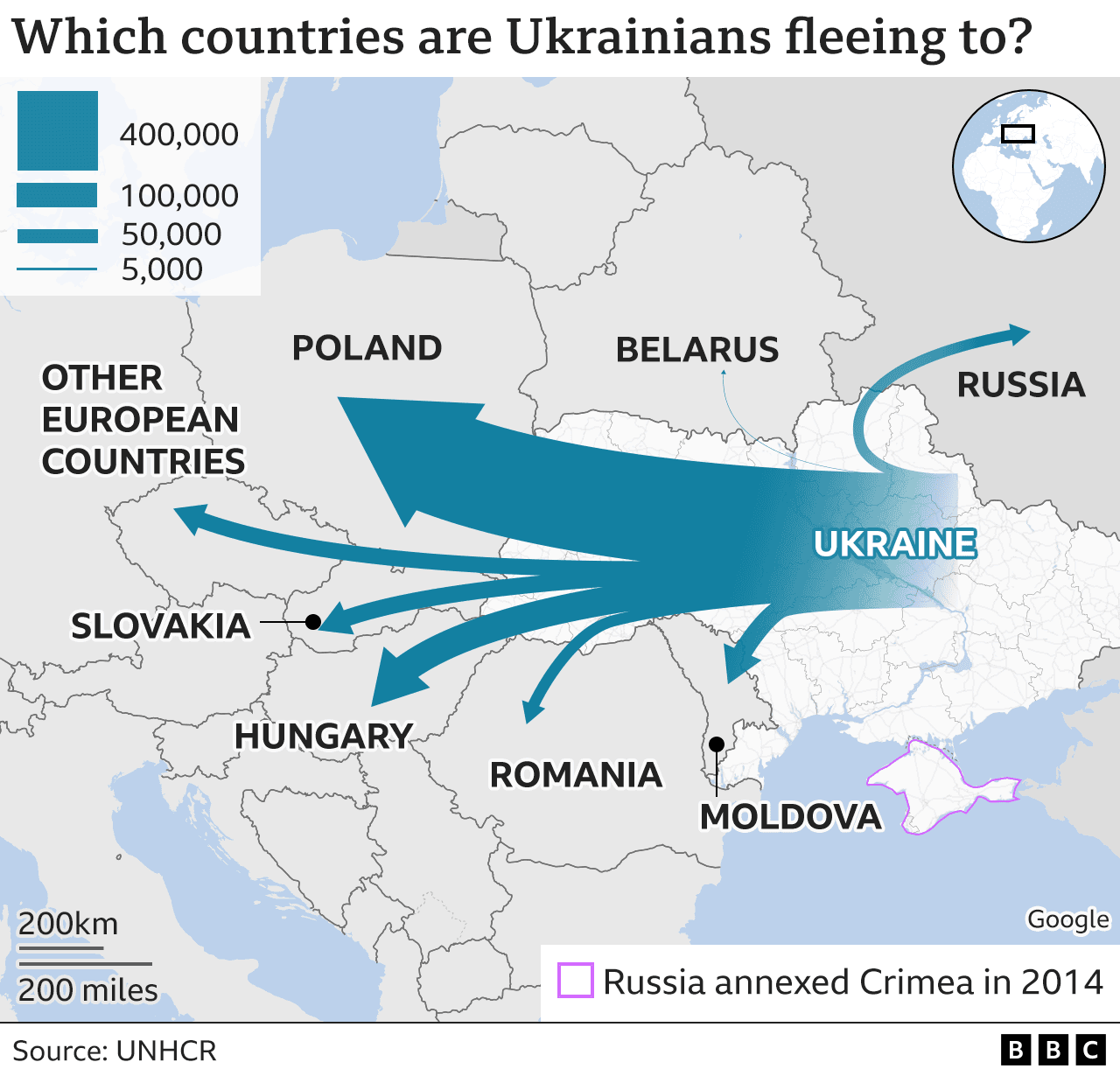BBC News 4 March 2022 - by The Visual Journalism Team
More than a week into Russia's invasion of Ukraine, its troops have made significant advances into the country but have so far failed to take the capital Kyiv.
Here are the latest developments on day nine of the invasion:
- Russian forces have seized the largest nuclear plant in Europe, Ukrainian authorities say
- The besieged port city Mariupol has been under consistent attack overnight
- Russian forces are in control of the key southern port city of Kherson
- The northern city of Chernihiv has come under fire but reports of casualties are unclear
- There are reports the eastern city of Sumy has been surrounded by Russian troops
Russia launched its attack in the early hours of 24 February from three main directions: north, south and east.
Since then, troops have poured into Ukraine and targets across the country have been struck by air strikes and artillery attacks.
So far about 250 Ukrainian civilians have been killed and many hundreds more injured, according to the United Nations - although local emergency services say the figure is much higher.
The fight for Kyiv
Russian troops have been advancing on Kyiv from the north, although progress has slowed in recent days.
On Thursday, the UK Ministry of Defence (MoD) said that a long convoy of Russian military vehicles heading for the capital had been stalled by "staunch Ukrainian resistance, mechanical breakdown and congestion".
But attacks on the capital have continued. Defence analysts say the aim of the Russian forces is envelope and eventually encircle the city.
Hostomel airport has been the scene of fierce fighting and has changed hands multiple times in the past few days, according to the Institute for the Study of War (ISW).
Russian forces arrived near Obolon on the outskirts of Kyiv on 25 February and clashes in north-western Kyiv were reported at the weekend.
But so far Russian tanks and armoured vehicles have not been seen in the capital.
More coverage of Ukraine crisis
- LIVE: Latest updates from on the ground
- THE BASICS: Why is Putin invading Ukraine?
- RUSSIA: Watching the war on TV
- UKRAINE: 'I have never felt so much love for my homeland'
- IN DEPTH: Full coverage of the conflict
Strike from the north
Russian forces have been advancing on Chernihiv, to the northeast of Kyiv, but have faced strong resistance and the city remains in Ukrainian hands.
Russian troops are believed to have surrounded the city of Sumy, where local people reported loud explosions and loss of power. The city came under fire overnight.
The most rapid advance on Kyiv has come down the west side of the Dnieper river via Chernobyl, with the Russians taking control of a large area to the north and west of the capital.
The MoD says the main body of the large Russian column advancing on Kyiv remains over 30km (19 miles) from the centre of the city.
Strike from the east
Kharkiv, the second-largest city in Ukraine, has faced intense aerial bombardment in recent days.
On Wednesday, the city's mayor said the heavy shelling had killed at least 21 people and wounded more than 100 others.
Russian paratroopers were reported to have been seen on the outskirts of the city but so far the Ukrainian military has managed to keep hold of the city.
Analysts at ISW suggest Russian forces will try to encircle the city before bombarding it to force a surrender.
Shelling has also continued around Donetsk, which has come under attack from troops crossing from Belgorod in western Russia.
There are thought to be about 15,000 Russian-backed separatists in Donetsk and Luhansk, who may help a Russian advance. Ukraine believes the figure is higher.
Strike from the south
Russian forces from the south have seized the Zaporizhzhia nuclear plant, the largest in Europe, Ukrainian authorities say. They shelled the site, before seizing control. Ukrainian authorities say power station staff continue to work and monitor the state of the power units.
Russian forces have now taken control of the port city of Kherson - the first major city to fall.
The city's mayor posted a message on Facebook informing residents that the Ukrainian flag still flies over their city, but there were no Ukrainian forces left. Russian forces in the south are now targeting Mykolaiv.
Meanwhile, the port city of Mariupol continues to come under sustained attack and its mayor has warned of a deepening humanitarian catastrophe there.
A pro-Russian rebel spokesman said on Thursday that they would launch "targeted strikes" against the city unless Ukrainian forces surrender.
An advance from Mariupol to the east would create a land bridge between Crimea and territory held by pro-Russian separatists in Donetsk and Luhansk.
In the days leading up to the invasion, Russia positioned landing ships capable of deploying main battle tanks, armoured vehicles and personnel, off the Ukrainian coast in a major build-up in the Black Sea and the Sea of Azov.
Thousands flee across borders
Since the invasion began, more than one million people have fled Ukraine, according to the United Nations.
The European Union estimates that up to four million people may try to leave the country because of the Russian invasion.
Refugees are crossing the borders to neighbouring countries to the west, such as Poland, Romania, Slovakia, Hungary and Moldova.
By David Brown, Bella Hurrell, Dominic Bailey, Mike Hills, Lucy Rodgers, Paul Sargeant, Mark Bryson, Zoe Bartholomew, Sean Willmott and Sana Dionysiou.
About these maps
To indicate which parts of Ukraine are under control by Russian troops we are using daily assessments published by the Institute for the Study of War with the American Enterprise Institute's Critical Threats Project.
From 2 March this daily assessment differentiated between "Assessed Russian-controlled Ukrainian territory" and "Assessed Russian advances in Ukraine", the latter indicating areas where Russians are believed to have launched attacks from but which they do not control.
To show key areas where advances are taking place we are also using daily updates from the UK Ministry of Defence and BBC research. To show locations where there have been attacks or explosions we are using reports that have been verified by the BBC.
The situation in Ukraine is fast moving and it is likely there will be times when there have been changes not reflected in the maps.

